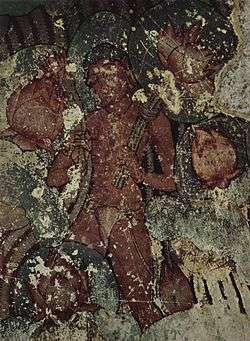Kaupinam
Kaupinam, kaupina or langot is an undergarment worn by Indian men as a loincloth or underclothing, usually by pehalwan exercising or sparring in dangal at traditional wrestling akharas. It is made up of rectangular strip of cotton cloth that is used to cover the genitals with the help of the strings connected to the four ends of the cloth for binding it around the waist of the wearer. It is used by wrestlers in the game of Kushti or traditional Indian wrestling in the akhada (wrestling ring) and during practice sessions and training.

Use
It is used extensively by wrestlers (pehelwans) in India participating in the traditional game of Pehlwani (a form of traditional wrestling). It is worn by wrestlers during matches, practice, training and exercises (kasrat).
The kaupinam in India is the traditional male sports gear associated with almost every form of physically straining sports like kushti and kabaddi. It has been worn by sportsmen and bodybuilders during training and exercise sessions (similar to the contemporary use of gym shorts) since ancient times and is still used in traditional sports. Langot was earlier worn (and is still worn sometimes) in India by men performing any form of physically straining activity. The wrestlers often wear a G-string-shaped guard underneath to protect their genitals.
The kaupinam is a very ancient form of sportswear and was in use since the early Vedic Period (2000–1500 BC) in India as is evident from a verse in the Sam Veda, the Hindu sacred scriptures, written at that time.[1] The devotees of Shiva were said to be wearing kaupinam.
Religious significance
Vedanta Vakyeshu sada ramayantah
Bikshanna matrena tustimantah
vishokamantah karane charantah
kaupina vantah kalu bagyavantah
Sri Shankaracharya
It has religious significance attached to asceticism for the Hindus. Bhagavata Purana enjoins that a true ascetic should not wear anything other than a kaupina.[2] Sometimes Lord Shiva himself is depicted wearing Kaupina.[3] Even Lord Murugan of Palani and Hanuman are said to be wearing this garment.[4] Langot or kaupin is associated with celibacy.[5] Sri Shankaracharya composed a verse called Kaupina Panchakam to assert the significance of asceticism. Famous Maharashtrian saint Samarth Ramdas and Tamil saint Ramana Maharshi were always depicted wearing a langot in popular pictures.
Langota
Langota or Langoti is a traditional style of Indian loincloth for men, and a more modern form of the kaupinam. It is distinct from the older form as it is sewn and covers the buttocks. It was worn as underwear in dangal held in akharas. It is now mainly used by men when exercising and other intense physical games especially wrestling, to prevent hernias and hydrocele.[6]
The loincloth is about 3" wide and 24" long single piece of cotton cloth. It is first put between the legs and then wrapped around the waist very tightly.
See also
- Similar Indian clothes
- Related Indian clothes
- Similar foreign clothes
- Related foreign clothes
- Tallit katan
- Temple garment: religious undergarments worn by many Mormons
References
- Alter, Joseph S. (1992). The wrestler's body: identity and ideology in north India. University of California Press. pp. 305 pages. ISBN 9780520076976.
- Śrīmad Bhāgavatam 7.13.2 Archived 2013-10-19 at the Wayback Machine, Bhaktivedanta VedaBase
- Narayana Ayyar, C. V. (1939). Origin and early history of Śaivism in South India. Madras University historical series. Volume 6. University of Madras. pp. 155, 185.
- Lutgendorf, Philip (2007). Hanuman's tale: the messages of a divine monkey Oxford scholarship online. Oxford University Press. pp. 434 pages(see:186). ISBN 9780195309225.
- Abbott, Elizabeth (2001). A history of celibacy. James Clarke & Co. pp. 493 pages. ISBN 9780718830069.
- Raman Das Mahatyagi (2007). Yatan Yoga: A Natural Guide to Health and Harmony. YATAN Ayurvedics. pp. 33–. ISBN 978-0-9803761-0-4.
External links
- How to wear, visual description.
- "The Langota". Yatan Holistic Ayurvedic Centre. Retrieved 10 August 2012.